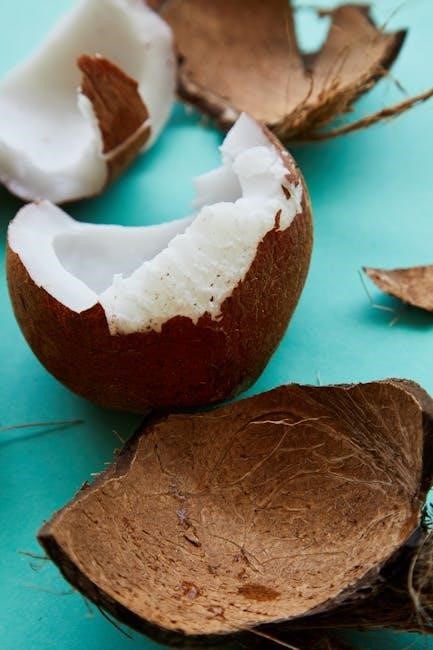Discover Dr. Gundry’s innovative approach to lectin-free eating, designed to reduce inflammation and improve gut health. This plan offers delicious, easy-to-follow recipes and a structured 30-day meal guide.
Overview of the Plant Paradox Diet
The Plant Paradox Diet, developed by Dr. Steven Gundry, focuses on eliminating lectins, harmful plant proteins found in certain foods. By avoiding lectin-rich foods like beans, grains, and nightshades, the diet aims to reduce inflammation, improve gut health, and promote weight loss. It emphasizes nutrient-dense, lectin-free alternatives such as leafy greens, cruciferous vegetables, and healthy fats. The diet is structured around a 30-day meal plan, providing clear guidelines and recipes to help individuals transition to a lectin-free lifestyle. With a strong emphasis on whole, unprocessed foods, the Plant Paradox Diet offers a sustainable approach to improving overall health and well-being. Its simplicity and focus on nourishing ingredients make it accessible for those seeking long-term dietary changes.
Importance of a Lectin-Free Diet
A lectin-free diet is crucial for reducing inflammation and improving gut health, as lectins can cause damage to the intestinal lining and lead to a leaky gut. By eliminating high-lectin foods, individuals may experience fewer digestive issues and reduced inflammation, which can contribute to chronic diseases.
Dr. Gundry’s approach emphasizes that lectins, found in foods like beans, grains, and certain vegetables, can disrupt nutrient absorption and overall well-being. A lectin-free diet promotes better digestion, increased energy, and may even help manage weight and autoimmune conditions. This dietary strategy is particularly beneficial for those seeking to address underlying health concerns through food choices.
By focusing on lectin-free alternatives, the diet supports long-term health and vitality, making it a sustainable option for those committed to improving their well-being.

Core Principles of the Plant Paradox Meal Plan
The plan focuses on eliminating lectins, promoting nutrient-dense foods, and balancing macronutrients to support overall health and reduce inflammation through strategic dietary choices.
Understanding Lectins and Their Impact on Health
Lectins are naturally occurring proteins found in plants, acting as a defense mechanism to protect them from predators. While some lectins are harmless, others, particularly in high amounts, can cause inflammation, gut damage, and autoimmune responses in humans. Dr. Steven Gundry’s Plant Paradox diet highlights how certain lectins, found in foods like beans, grains, and nightshades, can disrupt gut health and lead to chronic conditions. By eliminating or minimizing these lectin-rich foods, the diet aims to reduce inflammation, improve nutrient absorption, and promote overall well-being. Understanding lectins is crucial for adhering to the meal plan, as it helps individuals make informed choices about which foods to avoid and how to prepare others to minimize lectin content.

Key Foods to Avoid and Why
The Plant Paradox meal plan emphasizes eliminating foods high in lectins, which can trigger inflammation and digestive issues. Avoid beans, lentils, wheat, and certain vegetables like tomatoes and eggplants, as they contain harmful lectins. Dairy products, nuts, and seeds are also restricted due to their lectin content. Processed foods and sugary snacks should be avoided to maintain a lectin-free diet. These foods can disrupt gut health and lead to chronic inflammation. By eliminating them, the diet aims to reduce inflammation, improve digestion, and promote overall well-being. Understanding which foods to avoid is crucial for adhering to the plan and achieving its benefits. Focus on replacing these items with lectin-free alternatives to maximize the diet’s effectiveness and support long-term health goals.

Benefits of a Lectin-Free Diet

Adopting a lectin-free diet offers numerous health benefits, including reduced inflammation and improved gut health. Many followers report enhanced nutrient absorption and digestion. By eliminating lectins, the diet helps minimize digestive discomfort and supports weight loss. It also promotes clearer skin and increased energy levels. The Plant Paradox meal plan PDF provides guidance on achieving these benefits through tailored recipes and structured eating plans. Overall, the lectin-free approach focuses on nourishing the body while avoiding harmful compounds, leading to better overall well-being and longevity.

Structure of the Plant Paradox Meal Plan
The Plant Paradox Meal Plan is organized into daily meals, including breakfast, snacks, lunch, and dinner. It offers a 30-day structured plan and a 3-day kickstart guide for beginners, supported by shopping lists and a food pyramid to ensure adherence and ease of implementation.
Breakfast Ideas for a Lectin-Free Diet

Start your day with delicious and nutritious lectin-free breakfast options; Enjoy spinach, avocado, and smoked salmon omelets, or try zucchini boats filled with pasture-raised eggs. Smoothies made with almond milk, berries, and a scoop of lectin-free protein powder are also a great choice. For a hearty meal, consider roasted sweet potato hash topped with bacon or sausage. Many recipes in the Plant Paradox meal plan PDF emphasize using lectin-free ingredients like cauliflower pancakes or chia pudding with fresh fruits. These breakfast ideas not only align with the diet’s principles but also provide sustained energy and support overall health. Incorporating these meals into your routine can help reduce inflammation and improve digestion, making them a perfect way to kickstart your day.
Snack Options That Align with the Plan
Snacking on the Plant Paradox meal plan is both satisfying and healthy, focusing on lectin-free options to support gut health. High-protein, low-carb bars made with nuts and seeds are a convenient choice. Roasted vegetables like cauliflower, zucchini, and baby cucumbers, peeled and seeded, make for crunchy and nutritious snacks. Fresh arugula or leafy greens paired with olive oil and herbs are also great options. For a quick pick-me-up, consider a small portion of avocado or a handful of berries, which are naturally low in lectins. These snacks not only reduce inflammation but also keep you fueled between meals, aligning perfectly with Dr. Gundry’s approach to a lectin-free lifestyle. Keeping these snacks prepped ensures you stay on track while enjoying delicious flavors.
Lunch and Dinner Recipes to Enjoy

The Plant Paradox meal plan offers a variety of delicious and nutritious lectin-free recipes for lunch and dinner. Some popular options include roasted Cauliflower with Sage, Arugula salad with mushrooms, and grilled chicken breast. These dishes are not only flavorful but also align with Dr. Gundry’s guidelines for reducing inflammation and improving gut health. Additionally, the plan provides creative ideas for incorporating lectin-free ingredients into hearty meals, such as zucchini noodles with pesto or stuffed bell peppers. With a focus on fresh, seasonal produce and lean proteins, these recipes make it easy to enjoy satisfying meals while staying on track. The meal plan also includes tips for meal prepping and organizing your weekly menu to ensure success.

Sample 30-Day Meal Plan
Dr. Gundry’s 30-day plan includes 60 delicious, gluten-free recipes, guiding you through breakfast, lunch, dinner, and snacks, all aligned with lectin-free eating principles for better health.
Weekly Shopping List for Success
A well-organized shopping list is essential for adhering to the Plant Paradox meal plan. Focus on lectin-free foods, including peeled and seeded vegetables like cucumbers, zucchini, and eggplant. Include leafy greens, avocado, and low-sugar fruits such as berries. Opt for grass-fed meats, wild-caught fish, and pasture-raised eggs. Healthy fats like olive oil, avocado oil, and coconut oil are also key. Don’t forget to stock up on gluten-free alternatives and low-carb, high-protein snacks. Refer to Dr. Gundry’s food pyramid for guidance, ensuring you avoid high-lectin foods like beans, grains, and certain nuts. A printable shopping list is available in the PDF, making meal prep and grocery shopping easier. Always check your pantry before shopping to avoid waste and ensure you have all the necessary ingredients for your weekly meals.
3-Day Kickstart Plan for Beginners
The 3-Day Kickstart Plan is designed to help newcomers transition smoothly into the Plant Paradox diet. Developed by Irina Skoeries of Catalyst Cuisine, this plan offers simple, flavorful recipes to ease into lectin-free eating. Breakfast options include high-protein, low-carb bars, while snacks like fresh veggies and nuts keep energy levels steady. Lunch and dinner ideas, such as roasted cauliflower with sage and arugula salad with mushrooms, are both nutritious and satisfying. This plan emphasizes convenience, ensuring that even those new to the diet can enjoy delicious meals without feeling overwhelmed. By focusing on whole, lectin-free ingredients, the 3-Day Kickstart Plan sets the foundation for long-term success on the Plant Paradox journey.
- Chicken breast with roasted vegetables
- Arugula salad with mushrooms
- High-protein, low-carb snacks
Common Challenges and Solutions
Addressing constipation on the plan
- Socializing and celebrating while staying on track

Addressing Constipation on the Plan
Constipation can sometimes occur when transitioning to the Plant Paradox meal plan, often due to the removal of high-fiber lectin-containing foods. To alleviate this, increase your intake of approved vegetables like peeled cucumbers, zucchini, and leafy greens, which are gentle on the digestive system. Staying hydrated is crucial, so drink plenty of water throughout the day. Incorporating physical activity, such as daily walks, can also help stimulate bowel movements. If constipation persists, consider adding small portions of pressure-cooked or well-digested foods like sweet potatoes or cauliflower rice. Dr. Gundry recommends avoiding processed fiber supplements and instead focusing on natural, lectin-free sources. Ensure you’re eating enough healthy fats, such as avocado or olive oil, to support digestive health. Patience is key, as your body may need time to adjust to the new diet.
Socializing and Celebrating While Staying on Track
Staying on the Plant Paradox meal plan doesn’t mean missing out on social events or celebrations. With a little creativity, you can enjoy gatherings while maintaining your lectin-free diet. Consider bringing your own lectin-free dish to share, ensuring there’s something you can eat. Opt for grilled meats, roasted vegetables like zucchini or eggplant, or salads with olive oil and vinegar dressing. If dining out, choose restaurants with flexible menus and communicate your dietary needs. Focus on the social aspect rather than food, and don’t hesitate to politely decline non-compliant options. Planning ahead and preparing snacks or meals in advance can also help you stay on track. Celebrations can still be joyful and satisfying without compromising your health goals. The key is to stay mindful and prepared, ensuring you thrive socially while adhering to your lectin-free lifestyle.
The Plant Paradox meal plan offers a transformative approach to lectin-free eating, promoting long-term health and wellness through delicious, structured recipes and mindful food choices.
Final Tips for Long-Term Success
For lasting success on the Plant Paradox meal plan, consistency and preparation are key. Plan your meals weekly and use the shopping list to stay organized. Experiment with new lectin-free recipes to keep your diet exciting. Staying hydrated and incorporating physical activity will enhance the benefits of the plan. Be mindful of portion sizes, even with approved foods. Track your progress and adjust as needed to maintain motivation. Building a support system, such as joining a community or sharing meals with others, can help you stay on track. Finally, consult with a healthcare professional to ensure the plan aligns with your personal health goals. By adhering to these tips, you can enjoy long-term wellness and vitality on the Plant Paradox diet.



